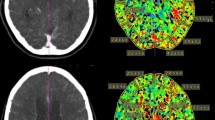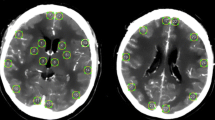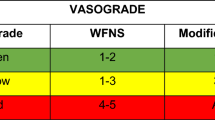Summary
In order to predict the occurrence of cerebral infarction after aneurysmal surgery in patients with subarachnoid haemorrhage, we measured the amount of subarachnoid blood on initial and on post-operative computed tomograms. We used a reliable grading method to estimate the amount of blood on computed tomograms in 24 patients with infarction due to vasospasm and 45 patients without cerebral infarction, all of whom underwent aneurysmal surgery within 48 hours after the ictus.
The total amount of subarachnoid blood on admission and on the day after operation was more in the cerebral infarction group than in the non-infarction group. The clearance rate of subarachnoid blood by surgery was lower in patients with cerebral infarction than in patients without infarction and the predominant site of subarachnoid blood corresponded with the site of the infarct. Of 24 patients with cerebral infarction, 22 (92%) belonged to the group whose initial total blood score was more than 10 on admission and whose clearance rate by surgery was less than 50%.
Therefore, we propose this range to be an indication for the occurrence of cerebral infarction in postoperative patients due to cerebral vasospasm.
The presence of intracerebral haematoma and the amount of ventricular blood and their clearance by surgery were also estimated for the prediction of delayed cerebral infarction after aneurysmal surgery. However, they had no relation to the occurrence of cerebral infarction due to vasospasm.
Similar content being viewed by others
References
Allen GS, Ahn HS, Preziosi TJ, Battye R, Boone SC, Chou SN, Kelly DJ, Weir BK, Crabbe RA, Lavik PJ, Rosenbloom SB, Dorsey FC, Ingram CR, Mellits DE, Bertsch LA, Boisvert DPJ, Hundley MB, Johnson RK, Strom JA, Transou CR (1983) Cerebral arterial spasm: a controlled trial for nimodipine in patients with subarachnoid haemorrhage. N Engl J Med 308: 619–624
Bell BA, Kendall BE, Symon L (1980) Computed tomography in aneurysmal subarachnoid haemorrhage. J Neurol Neurosurg Psychiatry 43: 522–524
Brouwers PJAM, Wijdicks EFM, van Gijn J (1992) Infarction after aneurysmal rupture does not depend on the distribution of clearance rate of blood. Stroke 23: 374–379
Brouwers PJAM, Dippel DWJ, Vermeulen M, Lindsay KW, Hasan D, van Gijn (1993) Amount of blood on computed tomography as an independent predictor after aneurysm rupture. Stroke 24: 809–814
Davis JM, Davis KR, Crowell RM (1980) Subarachnoid haemorrhage secondary to ruptured intracranial aneurysm: prognostic significance of cranial CT. AJNR 1: 17–21
Fisher CM, Kistler JP, Davis LM (1980) Relation of cerebral vasospasm to subarachnoid haemorrhage visualized by computerized tomomgraphic scanning. Neurosurgery 6: 1–9
Fujita S (1985) Computed tomographic grading with Hounsfield number related to delayed vasospasm in cases of ruptured cerebral aneurysm. Neurosurgery 17: 609–612
Gurusinghe NT, Richardson AE (1984) The value of CT in aneurysmal subarachnoid haemorrhage: the concept of a CT score. J Neurosurg 60: 763–770
Hijdra A, Brouweres PJAM, Vermeulen M, van Gijn J (1990) Grading the amount of blood on computed tomograms after subarachnoid haemorrhage. Stroke 21: 1156–1161
Hunt WE, Kassell N, Pertuiset B, Sano K, Teasdale G, de Villier JC, Drake CG (1988) Report of the World Federation of Neurological Surgeons Committee on a Universal Subarachnoid Haemorrhage Grading Scale. J Neurosurg 68: 985–986
Inagawa T, Kamiya K, Ogasawara H, Yano T (1987) Rebleeding of ruptured intracranial aneurysms in the acute stage. Surg Neurol 28: 93–99
Kassell NF, Torner JC, Haley EC, Jane JA, Adams HP, Kongable GL, and participants (1990) The International Cooperative Study on the timing of aneurysm surgery: Part 1. Overall management results. J Neurosurg 73: 18–36
Kodama N, Sasaki T, Watanabe Z (1986) Prevention of vasospasm — Cisternal irrigation therapy with urokinase and ascorbic acid, In: Kikuchi H, Fukushima T, Watanabe K (eds) Intracranial aneurysms-surgical timing and techniques. Nishimura, Niigata, pp 228–242
Ljunggren B, Saveland H, Brandt L, Zygmunt S (1985) Early operation and overall outcome in aneurysmal subarachnoid haemorrhage. J Neurosurg 62: 547–551
Mizoi K, Yoshimoto T, Fujiwara S, Sugawara T, Takahashi A (1991) Prevention of vasospasm by clot removal and intrathecal bolus injection of tissue-type plasminogen activator: preliminary report. Neurosurgery 28: 807–813
Mizukami M, Kawase T, Usami T, Tazawa T (1981) Prevention of vasospasm by early operation with removal of subarachnoid blood. Neurosurgery 10: 301–307
Mohsen F, Pomonis S, Illingworth R (1984) Prediction of delayed cerebral ischaemia after subarachnoid haemorrhage by computed tomography. J Neurol Neurosurg Psychiatry 47: 1197–1202
Pasqualin A, Rosta L, Da Pian R, Cavazzani P, Scienza R (1984) Role of computed tomography in the management of vasospasm after subarachnoid haemorrhage. Neurosurgery 15: 344–353
Petruk CK, West M, Mohr G, Weir BK, Benoit BG, Gentili F, Disney LB, Khan MI, Grace M, Holness RO, Karwon MS, Ford RM, Cameron GS, Tucker WS, Parves GB, Miller JDR, Hunter KM, Richard MT, Durity FA, Chan R, Clein LJ, Maroun FB, Godon A (1988) Nimodipine treatment in poor grade aneurysm patients. J Neurosurg 68: 505–517
Sano H, Kanno T, Shinomiya Y, Katada K, Katoh Y, Nakagawa T, Adachi K (1982) Prospection of chronic vasospasm by CT findings. Acta Neurochir (Wien) 63: 23–30
Seifert V, Eisert WG, Storke D, Goetz C (1989) Efficacy of single intracisternal injection for recombinant tissue plasminogen activator to prevent delayed cerebral vasospasm after experimental subarachnoid haemorrhage. Neurosurgery 25: 590–598
Suzuki J, Komatsu S, Sato T, Sakurai Y (1980) Correlation between CT findings and subsequent development of cerebral infarction due to vasospasm in subarachnoid haemorrhage. Acta Neurochir (Wien) 55: 63–70
Suzuki J, Kodama N, Yoshimoto T, Mizoi K (1982) Ultraearly surgery of intracranial aneurysms. Acta Neurochir (Wien) 63: 185–191
Taneda M (1982) Effect of early operation for ruptured aneurysms on prevention of delayed ischaemic symptoms. J Neurosurg 57: 622–628
Teasdale GM (1988) A universal subarachnoid haemorrhage scale: Report of a Committee of the World Federation of Neurosurgical Societies. J Neurol Neurosurg Psychiatry 51: 1457–1463
Teasdale GM, Jennett B (1974) Assessment of coma and impaired consciousness. A practical scale. Lancet 2: 81–84
Author information
Authors and Affiliations
Rights and permissions
About this article
Cite this article
Hirashima, Y., Kurimoto, M., Takaba, M. et al. The use of computed tomography in the prediction of delayed cerebral infarction following acute aneurysm surgery for subarachnoid haemorrhage. Acta neurochir 132, 9–13 (1995). https://doi.org/10.1007/BF01404841
Issue Date:
DOI: https://doi.org/10.1007/BF01404841




